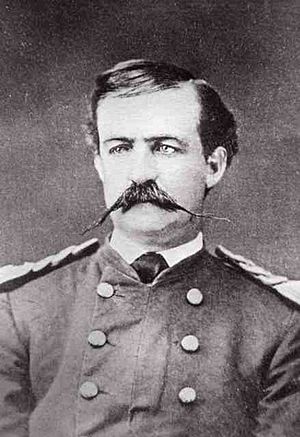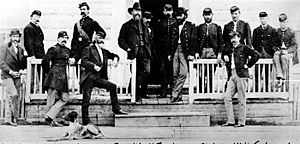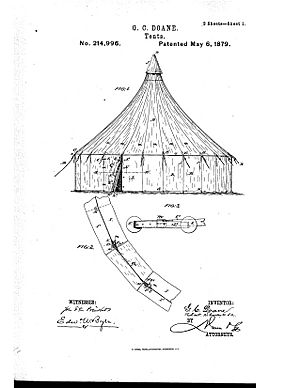Gustavus Cheyney Doane facts for kids
Quick facts for kids
Gustavus Cheyney Doane
|
|
|---|---|

Lt. Doane, 1875
|
|
| Nickname(s) | Gus |
| Born | May 29, 1840 Galesburg, Illinois |
| Died | May 5, 1892 (aged 51) Bozeman, Montana |
| Buried |
Sunset Hills Cemetery, Bozeman, Montana
(45°40′31.93″N 111°01′35.38″W / 45.6755361°N 111.0264944°W) |
| Service/ |
US Army |
| Years of service | 1862–1865, 1868–1892 |
| Rank | Captain |
| Battles/wars | American Civil War |
Gustavus Cheyney Doane (May 29, 1840 – May 5, 1892) was a brave U.S. Army Cavalry Captain and explorer. He was also an inventor and a soldier in the American Civil War. Doane played a big part in exploring Yellowstone. He was a member of the Washburn–Langford–Doane Expedition. Doane was also involved in the Marias Massacre.
Contents
Early Life and Education
Gustavus Cheyney Doane was born in Galesburg, Illinois, on May 29, 1840. He was the oldest of six children. His family moved a lot when he was young. They lived in St. Louis, Missouri, then Oregon Territory, and finally Santa Clara, California.
Growing up in California, Doane was inspired by General John C. Frémont, a famous explorer. In 1857, Gustavus Doane started college at California Wesleyan College. He graduated in 1861, being first in his class for Latin, Greek, and math.
Serving in the Civil War
Doane wanted to join the American Civil War. In October 1862, at age 22, he volunteered in San Francisco. He joined a group called the California 100. These volunteers paid their own way to Boston. They joined the U.S. Army in January 1863.
A month later, Doane became a sergeant. He fought in battles near Washington, D.C.. In March 1864, he moved to a different unit in Vicksburg, Mississippi. He was honorably discharged from the Army in January 1865.
After the war, Doane tried to start a business in Yazoo City, Mississippi. It did not work out. He also tried politics, becoming Justice of the Peace and Mayor. But he left Mississippi in May 1868.
Life at Fort Ellis
In 1868, Doane became a military officer again. He joined the U.S. Army 2nd Cavalry Regiment. After some training, his unit moved to Fort Ellis, Montana Territory. This fort was near Bozeman, Montana. Doane and his first wife, Amelia, arrived there in July 1869. By the fall, Doane was in charge of Company F.
In January 1870, Doane's company was part of an attack. They attacked a Blackfoot Indian camp on the Marias River. This event became known as the Marias Massacre.
Doane was often away from Fort Ellis because of his duties. This put a strain on his marriage. Gustavus and Amelia divorced in September 1878.
Doane remarried quickly. On December 16, 1878, he married 19-year-old Mary Lee Hunter. She was the daughter of a doctor from Fort Ellis. Mary Lee traveled with Doane to many military posts. They stayed married until his death in 1892. Mary Lee became known for her knowledge of Montana history. She died in 1952.
Exploring Yellowstone
In August 1870, Henry D. Washburn asked for a military escort for his Yellowstone exploration. Doane and five other soldiers were chosen. As the leader of this escort, Lt. Gustavus C. Doane helped a lot in the creation of Yellowstone National Park. The park was officially created on March 1, 1872.
Doane wrote a very detailed report about Yellowstone's natural wonders. This report helped convince the U.S. Congress to create the National Park.
A mountain peak in the Absaroka Range was first named for Lt. Doane. Later, it was called Colter Peak. In 1871, another peak in Yellowstone was named Mount Doane in his honor. However, in 2018, Native American leaders asked for it to be renamed. They said Doane led the Marias Massacre. In June 2022, the U.S. Board of Geographic Names changed the name to First Peoples Mountain. This was to remove names that were considered offensive.
Other Adventures and Explorations
Doane loved to explore. He led or joined several expeditions.
Hayden Geological Survey of 1871
In the summer of 1871, Doane joined the military escort for the Hayden Geological Survey of 1871. This survey explored Yellowstone under Ferdinand Vandeveer Hayden. Doane was praised for his pathfinding skills. However, Hayden's explorations got most of the credit for Yellowstone's creation. This made Doane feel resentful for many years.
1876 Snake River Expedition
In the fall of 1876, Doane planned an exploration of the Snake River. He hoped this trip would bring him fame. Doane wanted to take his soldiers over the Yellowstone plateau in early winter. He had a wooden boat that could be taken apart and carried by mules.
The trip was very difficult. There was deep snow and brutal cold. The boat was damaged on Yellowstone Lake. Supplies were lost. The party ran out of food and had to kill their animals to eat. The boat was completely wrecked on the Snake River.
On December 15, 1876, Doane and his troop were almost starving. They found a trapper's cabin. They finally reached Fort Hall, Idaho, in January 1877. Doane's superiors ordered him and his troops back to Fort Ellis. This expedition was considered a failure. It was Doane's last trip into the Yellowstone plateau.
1880 Howgate Arctic Expedition
In May 1880, Captain Henry W. Howgate planned an expedition to the North Pole. Doane joined this expedition. The goal was to explore Greenland. However, the Army and Navy stopped supporting the trip. Their ship, the Gulnare, was not safe for the sea.
Howgate found private money to continue. Doane captained the Gulnare. In August, the ship was damaged in a storm. The expedition had to be canceled.
Indian Campaigns
Doane was involved in several important events with Native American tribes during his Army career.
Battle of the Little Bighorn
In early 1877, Doane commanded Crow Indian scouts. They worked with Colonel Nelson A. Miles. Doane helped gain the Crow's support for the U.S. Army. After the Battle of the Little Bighorn, Doane helped move survivors to safety. In June 1877, Doane and his Crow scouts visited the battlefield. They recovered the remains of Colonel George Armstrong Custer.
Nez Perce War
In August and September 1877, Doane and his Crow scouts played a key role in capturing Chief Joseph and the Nez Perce tribe. This happened during the Nez Perce War. After Chief Joseph escaped a battle, the Nez Perce moved into Yellowstone. Doane and his scouts blocked their path down the Yellowstone River. This forced Chief Joseph to go east. This put the Nez Perce within reach of Colonel Miles's forces. Chief Joseph surrendered to Miles in October 1877.
Geronimo Campaign
In September 1884, Doane was promoted to Captain. He moved to the Presidio in San Francisco. In 1885, an Apache leader named Geronimo caused trouble in southern Arizona Territory. Doane's company was sent to Fort Bowie. Doane did not participate in the pursuit of Geronimo's forces for personal reasons. Geronimo surrendered in September 1886.
Doane had hoped to be involved in managing Yellowstone National Park. But because he was in Arizona, his company was not chosen for the job.
Inventor and Later Life
Later in his life, Doane invented a tent. He called it the Doane Centennial Tent. He received a patent for it on May 6, 1879. He tried to get the U.S. Army to use his tent widely. However, his efforts were not successful. The Army never widely adopted his tent design.
Throughout 1890 and 1891, Doane tried to become the Superintendent of Yellowstone National Park. He made many requests, but the U.S. Army did not support him. This was a big disappointment for him.
In February 1892, Doane returned to Bozeman, Montana. He was on medical leave and waiting to retire from the Army. He became sick during an influenza outbreak in April. Gustavus Cheyney Doane died in his sleep from heart failure on May 5, 1892. He was buried in Sunset Hills Cemetery in Bozeman. Many people in the Gallatin Valley mourned him. They remembered him as the explorer who discovered Yellowstone. He was survived by his second wife, Mary, who lived in Bozeman until her death in 1952.
Images for kids
See also
 In Spanish: Gustavus Cheyney Doane para niños
In Spanish: Gustavus Cheyney Doane para niños





